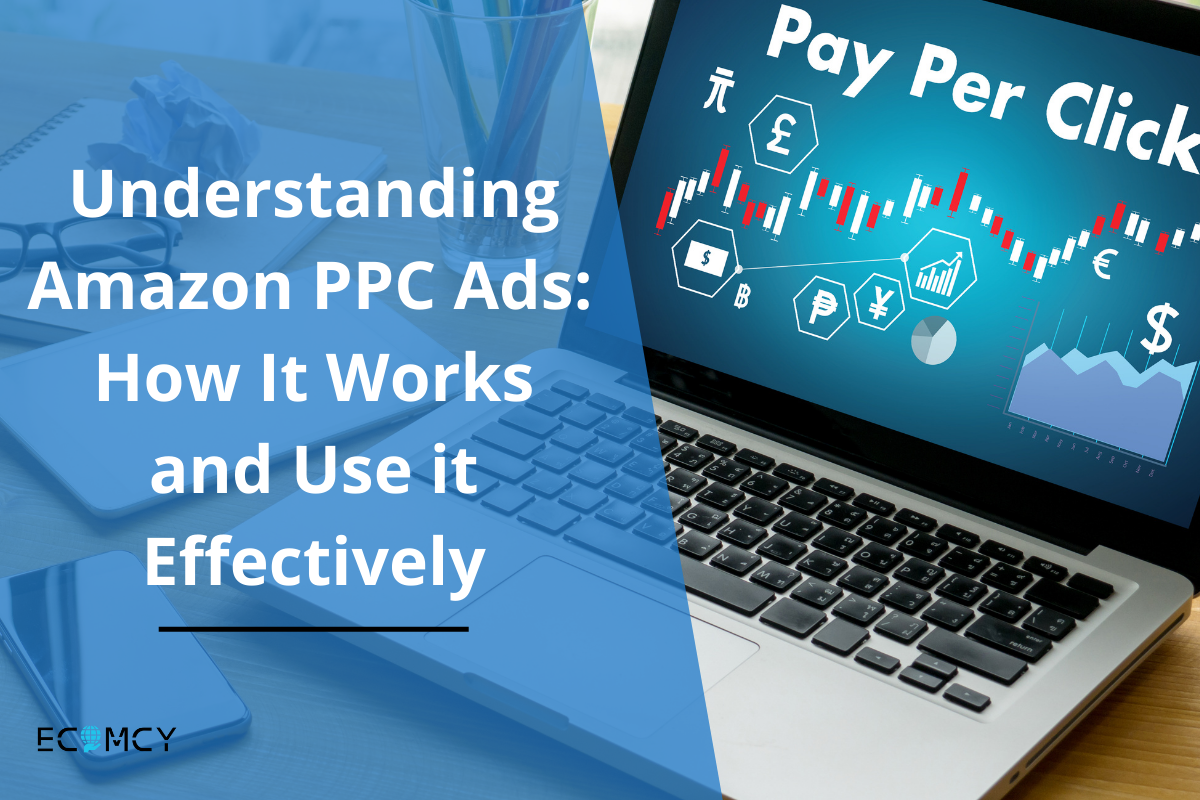May 17, 2022

Amazon PPC (Pay Per Click) is the advertising model that is employed on the Amazon website and marketplace. Advertisers compete for the right to have their adverts displayed on Amazon, with the highest bidder gaining the right to the most prominent advertising position available. Advertisers only pay Amazon the amount of money they have bid for their advertisement when a shopper clicks on it. Sponsored Products are a term used to refer to Amazon PPC advertisements.
As the name implies, businesses only pay for PPC advertisements when someone actually clicks on them. It is determined via a particular type of real-time auction in which they participate. In the case of a search word, the seller who offers the greatest price for the term will have their ad appear in the first place. The ad for the second-highest bidder is placed in the second spot, and so on down the line for the lower bidders. Sellers can change their bids to reflect when their adverts will appear on the market. So, for example, they may offer lower prices for advertisements that run during the night in a specific region than they would for advertisements that display during the early evening hours.
The larger the number of times consumers click on a pay-per-click advertisement, the greater the amount that seller will be required to pay Amazon. However, it is hoped that this would lead to an increase in product sales as a result.


Every month, Amazon receives millions of searches from users. They type in search terms (keywords) that range from single words to large phrases in the search box (long-tail keywords). The vast majority of individuals who use Amazon are there to make a purchase – they are not there to do some window shopping. The majority of the time, when people are looking for something specific, they will type the name of the brand or product in the search field. If consumers are less definite about their purchase, they are more inclined to type a more general search term into the search box, such as "Running Shoes" or even just "Shoes," to narrow their search results.
As a result of your search, Amazon retrieves a list of products for you. Generally speaking, these will be "organic" search results, which means they will not have been influenced by paid advertising. As long as the product listings are decent, Amazon will strive to identify the most relevant search results based on them by utilizing good search engine optimization (SEO).
Amazon, on the other hand, provides a second list of results, which it refers to as "Sponsored." These are the results of a paid search. In the Sponsored Ads section, if you hover your cursor over the small I sign, you will receive a notice from Amazon that says, "You are seeing this advertisement because it is relevant to your search query." Sponsored Ads are displayed in a variety of areas on Amazon, including above and beside organic results.
There are three types of Amazon PPC Ads. Here you will know which is the best fit ads for you.
1. Sponsored Product Ads
Sponsored Products are the most popular kind of advertising on Amazon. In a similar vein to Google Adwords, these are keyword- and ASIN (Amazon Standard Identification Number) targeted advertisements that allow you to promote specific products on Amazon's website. In terms of click-through rates and sales conversions, sponsored product advertisements consistently outperform the competition. The reason they are so effective is that they blend in with natural outcomes and mimic their appearance.
In order to begin running Sponsored Product advertisements, select a product, a keyword phrase, and a budget. When you do this, Amazon will automatically customize your sponsored advertisements to appeal to the most appropriate audience. They are usually seen in the following locations on Amazon: Top of search results, Alongside search results, Within search results, or on Product pages.
2. Sponsored Brand Ads
Advertisers use keywords for Sponsored Brands in the same way that they do for Sponsored Products in order to attract customers to their products. These ads appear in Amazon search results and feature your brand logo, a custom headline, and multiple products. Sponsored Brands have the potential to improve product sales as well as brand recognition among buyers who are considering their purchasing choices. In addition to advertising up to three products, Sponsored Brands can promote their Amazon store.
These Ads are usually seen on the first page of search results, in addition to the search results, or among the search results.
3. Sponsored Display Ads
Product pages, usually in a related product area, may have Sponsored Display Ads. These are pay-per-click advertisements that display on a product page. They serve relevant ads to shoppers who are currently exploring or have previously visited (remarketing) specific products on Amazon, both on Amazon and on third-party websites such as Facebook. These advertisements are meant to be used in conjunction with ASINs to provide advertisers with more options for focusing on behavioral groups.
There is a screen placement area, budget, and conversion rate for each ad kind, and click-through rates vary significantly between them. Amazon allows vendors to correlate each transaction with a specific target demographic when running a Display Ad campaign. Selling on Amazon allows you to target customers on the product's description page, comparable categories, related interests, and supplementary listings.
It is important that you choose an ad that matches your product category, target audience, and especially your goal. If the targeting technique is successful, Sponsored Display advertisements are placed below the "Add to Cart" button on Amazon product detail or product-related pages, adjacent to and below search results, or on third-party websites and apps, as appropriate.
Ad positions are extremely important in determining the profitability of pay-per-click (PPC) campaigns. In many cases, the first result, or in the case of Amazon, the first product, receives the greatest number of clicks, regardless of whether they are sponsored or organic results.
Who can use Amazon PPC ads?
In their Sponsored Advertising Guidelines and Acceptance Policies, Amazon has established regulations for purchasing pay-per-click (PPC) advertising. These specify the format and functionality of advertisements, as well as the content standards and product acceptance. According to the company, all advertisements must be appropriate for a general audience, accurately reflect the content of the landing page, be written in the language of the appropriate Amazon site, be clear and accurate, and only promote products that you either own or are authorized to resell or distribute, among other requirements.
Many forms of content are prohibited under their guidelines, including but not limited to:
In addition, the following conditions must be met in order to be eligible to use Amazon PPC sponsored ads:
Amazon's policies include a lengthy list of forbidden products, as well as an extra list of restricted products, some of which have varied criteria based on the market to which you are selling. Examples include the promotion of alcohol in some nations, but the promotion of alcoholic beverages is outlawed in countries such as Canada, the United States, India, and the United Arab Emirates.
Why is it important for Amazon Sellers to use PPC Ads?

Ecommerce firms and sellers have enormous chances to prosper as consumer shopping progressively moves online — and, more specifically, to Amazon.com. However, with the increase in online shopping traffic comes an increase in the number of competitors vying for the most sales.
It is almost impossible for Amazon businesses of any size to succeed without a successful PPC advertising strategy in place. Given that Amazon has over 350 million products, it is easy for postings to become lost in the crowd of other items for sale.
While your organic ranking — the position in which your product appears in search results as a consequence of natural selection — is crucial, adverts can help you reach a wider audience on the site.
If you compare Amazon PPC to other ad channels, it is often considered to be more effective because it allows you to target shoppers where they are most likely to purchase.
You may market your products on Amazon with highly visible placements, with adverts displaying on desktop and mobile browsers as well as on Amazon's mobile application.
With Amazon PPC, you have the flexibility to choose from a range of Amazon ad kinds based on your objectives, you have complete control over and flexibility in setting and scaling your budget, and you can easily check how your advertisements are performing with a variety of thorough reporting options.
A variety of targeting options, ranging from keywords to categories, brands, and goods (ASINs—Amazon Standard Identification Numbers), as well as retargeting on external websites, are available through Amazon PPC to guarantee that your message reaches the intended audience.
Factors that may Affect your PPC Ads placement
Now that you've learned about the many sorts of Amazon PPC advertisements, it's time to learn about how ad placement is selected. The majority of people believe that the highest bidder will always get the best site; however, this is not always the case. While the cost-per-click (CPC) is an important factor, it is not the sole one accountable for the results.
The following are the two most important criteria that influence ad placement:
Amazon CPC (cost per click): The person who has the highest CPC has a better chance of acquiring prime ad space on Amazon.
The probability of a client clicking on the advertisement is also a significant quality aspect. Amazon only receives payment for clicks when using Amazon PPC. Amazon does not benefit from first impressions. The better an advertisement's placement, the more probable it is that a customer will click on it.
With a well-converting and click-generating advertisement, you can afford to pay a lower price for an ad spot. The ability to reduce ACoS (advertising cost of sale) and maximize ROI (return on investment) using Amazon PPC is dependent on the quality of the product listing and ad wording.
Understanding your ACoS
When it comes to Amazon PPC campaigns, ACoS is a number that can help you determine how effective your campaign is. It is the relationship between ad spend and ad revenue. In essence, it assesses how much money you spend for every dollar of income generated by your business.
ACoS is calculated as (100 * ad spend) / ad income.
Having an ACoS that exceeds one hundred percent indicates that you are spending more money than you are generating in revenues.
There is no magic number that can be used to evaluate a campaign. It is impossible to determine the optimal ACoS without considering a variety of elements, including but not limited to product category, business strategy, and advertising objectives. You'll need to adjust your ACoS objectives in light of all of these considerations, and you'll need to develop tactics to achieve your target.
Key takeaways:
There is a great deal of information to comprehend, but a seller must understand the fundamentals of the business. However, this is only the beginning. Before you get started, we recommend that you read through our other Amazon PPC instructions and watch our tutorial videos. You might begin with an automated campaign to gather some important information. Aside from that, Amazon's algorithms do a respectable job of conducting the campaign.
Amazon, on the other hand, is a fiercely competitive marketplace in which to do business. Each dollar of wasted advertising expenditure equals one dollar less in profits. By executing manual campaigns, you can enhance your productivity to the greatest extent possible.
Comments will be approved before showing up.

WANT TO STAY AHEAD OF THE COMPETITION ?
Subscribe to stay on top of the best strategies in the field of Amazon & Walmart